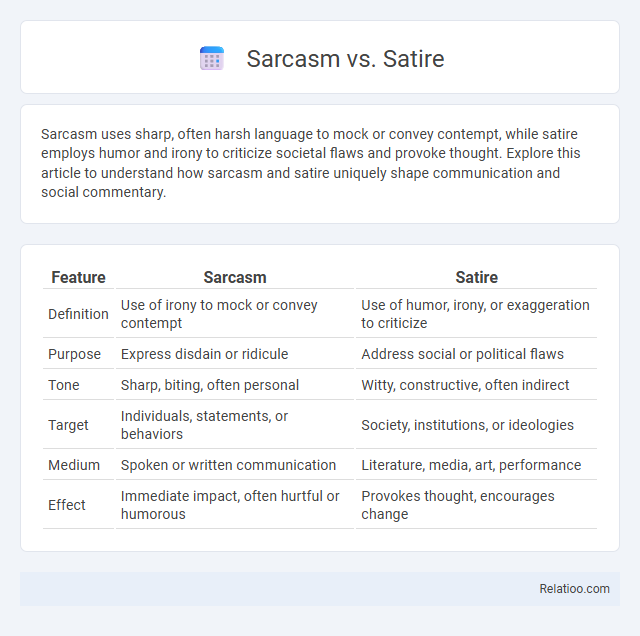Sarcasm uses sharp, often harsh language to mock or convey contempt, while satire employs humor and irony to criticize societal flaws and provoke thought. Explore this article to understand how sarcasm and satire uniquely shape communication and social commentary.
Table of Comparison
| Feature | Sarcasm | Satire |
|---|---|---|
| Definition | Use of irony to mock or convey contempt | Use of humor, irony, or exaggeration to criticize |
| Purpose | Express disdain or ridicule | Address social or political flaws |
| Tone | Sharp, biting, often personal | Witty, constructive, often indirect |
| Target | Individuals, statements, or behaviors | Society, institutions, or ideologies |
| Medium | Spoken or written communication | Literature, media, art, performance |
| Effect | Immediate impact, often hurtful or humorous | Provokes thought, encourages change |
Understanding Sarcasm: Definition and Key Features
Sarcasm is a form of verbal irony where someone says the opposite of what they truly mean, often with a sharp or cutting tone, to mock or convey contempt. Key features include exaggerated intonation, context-dependent meaning, and a target, whether an individual, idea, or situation. Unlike satire, which uses humor and irony more broadly to criticize social or political issues, sarcasm is typically more direct and personal in its expression.
What is Satire? Exploring Its Core Elements
Satire is a literary and artistic form that uses humor, irony, exaggeration, or ridicule to expose and criticize societal flaws, politics, or human vices. Core elements of satire include wit, sarcasm, parody, and social commentary aimed at provoking thought and reform. Unlike sarcasm, which is often a biting or mocking remark directed at an individual, satire employs broader, more structured narratives to deliver its critical message.
The Historical Roots of Sarcasm and Satire
Sarcasm, rooted in ancient Greek rhetoric, evolved as a sharp, often cutting form of verbal irony aimed at mockery or ridicule, while satire dates back to Roman times, particularly the works of Horace and Juvenal, who used humor and irony to criticize societal flaws and provoke reform. Your understanding of these distinctions enhances appreciation for how sarcasm targets individuals for immediate effect, whereas satire often addresses broader social issues through sophisticated literary techniques. Both forms have deeply influenced literary and cultural traditions by shaping public discourse and social commentary throughout history.
Tone and Intent: How Sarcasm Differs from Satire
Sarcasm employs a sharp, often mocking tone aimed at expressing contempt or ridicule, with the intent to hurt or criticize directly. Satire, by contrast, uses humor and irony more subtly, targeting societal flaws or human vices to provoke thought and promote change. You can distinguish sarcasm by its personal and biting tone, whereas satire adopts a broader, more constructive approach through wit and exaggeration.
Literary Devices: Techniques in Sarcasm and Satire
Sarcasm employs sharp, often cutting language to mock or convey contempt, relying heavily on tone and context to reveal its meaning, while satire uses irony, exaggeration, and parody to critique societal flaws and provoke thought or change. Both literary devices use humor as a tool, but satire typically involves a broader narrative structure and multilayered commentary, whereas sarcasm is usually brief and direct. Techniques such as verbal irony, hyperbole, and understatement are common in both, with satire often integrating allegory and symbolism to deepen its impact.
Common Examples in Popular Culture
Sarcasm often appears in stand-up comedy and sitcoms, with characters like Chandler Bing from *Friends* using biting remarks to convey humor or criticism. Satire is prominent in shows such as *The Daily Show* and movies like *Dr. Strangelove*, where social or political issues are exaggerated to provoke thought and highlight absurdities. Irony, frequently found in literature such as Jane Austen's works, uses contrasts between expectations and reality to emphasize deeper meanings or critiques.
Psychological Impact: Reader Perception and Interpretation
Sarcasm often triggers immediate emotional reactions by conveying contempt or irony, which can lead to misunderstanding or defensiveness in the reader due to its biting tone. Satire, employing humor and exaggeration to critique society or behavior, encourages reflective thinking and critical analysis, fostering deeper engagement with underlying issues. Sarcasm's psychological impact tends to be more personal and confrontational, whereas satire promotes social awareness and intellectual interpretation, shaping reader perception through distinct cognitive pathways.
The Role of Sarcasm and Satire in Social Commentary
Sarcasm employs sharp, often ironic language to mock or convey contempt, making it a powerful tool for critiquing social behaviors and injustices. Satire uses humor, irony, and exaggeration to expose societal flaws and provoke critical thinking, often addressing broader political and cultural issues. Understanding how sarcasm and satire shape social commentary can enhance your appreciation of the nuanced ways these forms influence public discourse and challenge the status quo.
Misconceptions and Pitfalls to Avoid
Sarcasm is frequently misunderstood as mere mockery, but it specifically involves ironic or cutting remarks aimed at ridicule, often leading to confusion in tone interpretation. Satire differs by using humor, irony, and exaggeration to expose and criticize societal flaws or individuals, yet it risks being misinterpreted as straightforward criticism if context is lacking. Avoid conflating sarcasm's personal bite with satire's broader social commentary, and be mindful that both can backfire if the audience misses underlying intent or tone cues.
Choosing the Right Approach: When to Use Sarcasm or Satire
Choosing the right approach between sarcasm and satire hinges on your communication goals and audience sensitivity. Sarcasm delivers sharp, often humorous critiques through irony, ideal for casual conversations or highlighting personal frustrations, while satire employs broader, exaggerated commentary to expose societal flaws in media, literature, or political discourse. Understanding your audience's tolerance for irony or humor ensures that your message is impactful without alienating listeners, making your choice between sarcasm and satire crucial for effective expression.

Infographic: Sarcasm vs Satire
 relatioo.com
relatioo.com